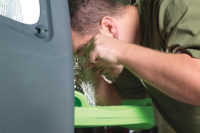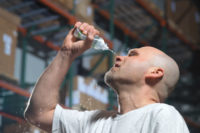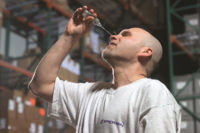
Reports of contaminated public water supplies have been on the rise since 2005 when the Environmental Working Group (EWG) found 141 unregulated chemicals in drinking water in 42 states. Today such findings are making headlines, raising concern about using unprotected plumbed tap water to flush injured eyes.
Pharmaceuticals & pathogens
- A recent Associated Press investigation revealed that a number of pharmaceuticals were found in the drinking water serving at least 41 million Americans. According to the report, officials in Philadelphia detected traces of 56 human and veterinary pharmaceuticals and their byproducts in the city’s water — just one example from the 28 cities studied. Unfortunately, the federal government does not require any testing and has yet to define safety limits for prescription drugs in plumbed water.
- In March 2008, a salmonella outbreak that sickened 200 people in Alamosa, Colo., was traced to the town’s tap water, closing schools for one week and prompting a ban on drinking or even touching tap water.
- Last fall, a former water department employee in Corpus Christi, Texas, found zero chlorine residuals in the city’s water, which meant there was no disinfectant present to kill bacteria in the city’s water lines.
- According to an April report on National Public Radio, the Environmental Protection Agency (EPA) has proposed loosening limits on contaminants in rural drinking water rather than forcing the facilities to make costly upgrades, even though many towns receive their drinking water directly from polluted streams and rivers.
Tap water has been used in plumbed eyewash stations for more than 100 years. While these stations easily meet the basic needs of the American National Standards Institute’s (ANSI) required 15-minute flush by delivering readily available water in plentiful amounts, there can be drawbacks, depending on the components of the plumbed system.
Because tap water’s pH and osmotic pressure (isotonicity) is incompatible with that of the eye, flushing with it can disrupt the eye’s protective epithelial layer and cause further damage to the already injured eye. In addition, some plumbed stations deliver tap water at the temperature of the water source; the flushing fluid in this case might be too cold or too hot for the recommended amount of flushing.
(Editor’s Note:Some plumbed eye/face wash stations use tempered water blending valves that mix hot and cold water for tempered flushing water; some models also employ anti-microbial pathogen protection filtration.)
In addition to the 141 unregulated chemicals that EWG found in its 2005 study, it also found 119 for which the EPA has set health-based limits. Most common were chlorine, disinfection byproducts, nitrates, chloroform, barium, arsenic and copper. Microorganisms and bacteria are also common in tap water and includeAcanthamoebae,Pseudomonas aeurginosaandB. cepacia,enteric bacilli,Entamoebaand other bacterial pathogens, some of which are proven to cause eye infections.
Jane Houlihan, EWG’s vice president for research, commented, “In many communities the water that comes out of the tap could be contaminated with scores of chemicals. People shouldn’t be alarmed, but they should be concerned. In this case, our system of public health protection isn’t working.”
EPA scientist Christian Daughton summarizes, “There isn’t such a thing as 100-percent pure water.”
Going sterile
The Food and Drug Administration requires that over-the-counter ophthalmic drugs such as eye drops and contact lens solution be sterile because “non-sterile eye drops pose an unacceptable risk of causing eye infections, which in rare cases could lead to blindness.” To date, the FDA does not enforce its own regulation, which requires emergency eyewash to be sterile. The FDA plans to issue a notice of proposed rulemaking (NPRM) on emergency first aid eyewashes in December 2008.
Self-contained portable eyewash systems and sealed-cartridge devices are not 100-percent sterile. Some self-contained portable systems still contain tap water; others are sealed-cartridge devices with buffered saline solutions that more closely mimic the pH of the eye.
An emergency eyewash delivery system that delivers 100-percent sterile flushing fluid and insures the proper pH and isotonicity is devoid of impurities that can harm the eye. Sterile eyewash solution must be prepared in FDA-approved clean rooms to assure purity. In addition, they:
- must be free of living organisms that can further damage an already injured eye;
- offer optimal protection from contaminants and bacteria that can cause secondary trauma;
- reduce the risk of potential liability if eye injury results;
- ensure that the water temperature remains tepid in order to accommodate the 15-minute flushing period required by ANSI; and
- enable workers to return to work sooner than if their eyes were further harmed by rinsing with tap water.
With reports of contaminated water making news, consider the potential risks of unprotected eyewash flushing using unadulterated tap water. Take time to consider and study emergency eyewash systems before purchasing and installing. Your decision could save your company thousands of dollars, speed your workers’ recovery and even prevent blindness. (Editor’s Note:The FDA, OSHA and ANSI do not require eyewashes to be sterile. You can choose from sterile solutions; buffered solutions; plumbed fixtures, some with components for anti-microbial pathogen protection, and systems using potable water combined with water preservative, to name a few systems on the market.)


